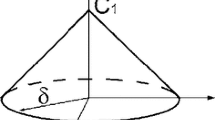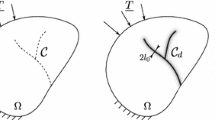Abstract
This note discusses the peridynamic horizon (the nonlocal region around a material point), its role, and practical use in modelling. The objective is to eliminate some misunderstandings and misconceptions regarding the peridynamic horizon. An example of crack branching in a nominally brittle material (homalite) is addressed and we show that crack branching takes place without wave interaction. We explain under what conditions the crack propagation speed depends on the horizon size and the role of incident stress waves on this speed.
Similar content being viewed by others
References
Agwai A., Guven I., Madenci E. (2011) Predicting crack propagation with peridynamics: a comparative study. Int. J. Fract. 171: 65–78
Bobaru F. (2011) Peridynamics and multiscale modeling. Int. J. Multiscale Com. Eng. 9(6): vii–ix
Bobaru F., Yang M., Alves L.F., Silling S.A., Askari E., Xu J. (2009) Convergence, adaptive refinement, and scaling in 1d peridynamics. Int. J. Numer. Meth. Eng. 77(6): 852–877
Bobaru F., Duangpanya M. (2010) The peridynamic formulation for transient heat conduction. Int. J. Heat Mass Tran. 53(19-20): 4047–4059
Bobaru F., Ha Y.D. (2011) Adaptive refinement and multiscale modeling in 2d peridynamics. Int. J. Multiscale Com. Eng. 9(6): 635–659
Field J.E. (1971) Brittle fracture: its study and application. Contemp Phys 12(1): 1–31
Ha Y.D., Bobaru F. (2010) Studies of dynamic crack propagation and crack branching with peridynamics. Int. J. Fract. 162(1-2): 229–244
Ha Y.D., Bobaru F. (2011) Characteristics of dynamic brittle fracture captured with peridynamics. Eng. Fract. Mech. 78(6): 1156–1168
Ha Y.D., Bobaru F. (2011b). Dynamic brittle fracture captured with Peridynamics. Proc. of IMECE 2011, November 11- 17, 2011, Denver, Colorado, USA: IMECE2011-65515.
Israelachvili, J.N. (1992). Intermolecular and Surface Forces. Academic Press, second edition.
Livne A., Ben-David O., Fineberg J. (2007) Oscillations in rapid fracture. Phys. Rev. Lett. 98(12): 124301
Ramulu M., Kobayashi A.S., Kang B.S.J., Barker D.B. (1983) Further studies on dynamic crack branching. Exp. Mech. 23(4): 431–437
Ramulu M., Kobayashi A.S. (1985) Mechanics of crack curving and branching: a dynamic fracture analysis. Int. J. Fract. 27: 187–201
Ravi-Chandar K. (1998) Dynamic fracture of nominally brittle materials. Int. J. Fract. 90(1-2): 83–102
Ravi-Chandar K. (2004). Dynamic fracture. Elsevier
Ravi-Chandar K., Knauss W.G. (1984) An experimental investigation into dynamic fracture - III. On steady state crack propagation and branching, Int. J. Fract. 26: 141–154
Scheibert J., Guerra C., Célarié F., Dalmas D., Bonamy D. (2010) Brittle-quasibrittle transition in dynamic fracture: An energetic signature, Phys. Rev. Lett. 104(4): 045501
Seleson P., Parks M.L., Gunzburger M., Lehoucq R.B. (2009) Peridynamics as an upscaling of molecular dynamics. Multiscale Model. Sim. 8(1): 204–227
Silling S.A. (2000) Reformulation of elasticity theory for discontinuities and long-range forces. J. Mech Phys Solids 48(1): 175–209
Silling S.A. (2011) A coarsening method for linear peridynamics. Int. J. Multiscale Com.Eng. 9(6): 609–621
Silling S.A., Bobaru F. (2005) Peridynamic modeling of membranes and fibers. Int. J. Nonlinear Mech. 40: 395–409
Silling S.A., Epton M., Weckner O., Xu J., Askari E. (2007) Peridynamic states and constitutive modeling. J. Elast. 88(2): 151–184
Silling S.A., Lehoucq R. (2008) Convergence of peridynamics to classical elast theory. J. Elast. 93: 13–37
Silling S.A., Lehoucq R.B. (2010) Peridynamic theory of solid mechanics. Adv. Appl. Mech. 44: 73–168
Streit R., Finnie L. (1980) An experimental investigation of crack-path directional stability. Exp. Mech. 20(1): 17–23
Weckner O., Silling S.A. (2011) Determination of nonlocal constitutive equations from phonon dispersion relations. Int. J. Multiscale Com. Eng. 9(6): 623–634
Author information
Authors and Affiliations
Corresponding author
Rights and permissions
About this article
Cite this article
Bobaru, F., Hu, W. The Meaning, Selection, and Use of the Peridynamic Horizon and its Relation to Crack Branching in Brittle Materials. Int J Fract 176, 215–222 (2012). https://doi.org/10.1007/s10704-012-9725-z
Published:
Issue Date:
DOI: https://doi.org/10.1007/s10704-012-9725-z




